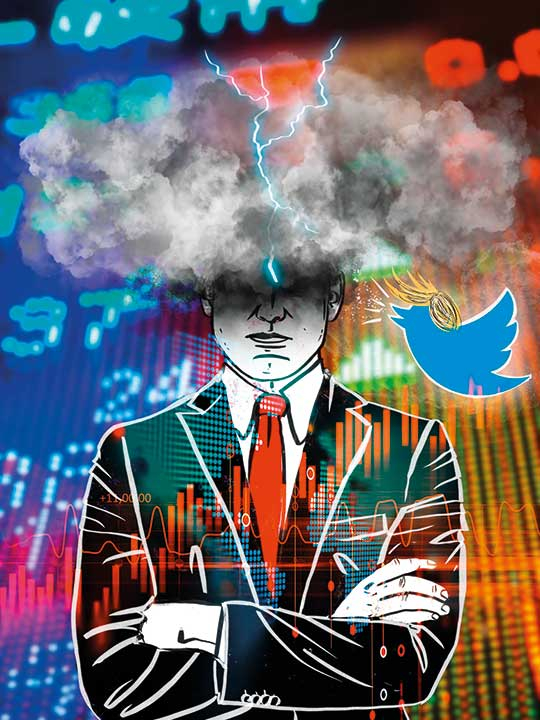Usually, older businessmen who are unhappy about what the Federal Reserve is doing grumble to their golfing buddies, or maybe appear as guests on CNBC. The US President prefers Twitter.
But in his latest complaints about monetary policy, President Donald Trump actually made a somewhat profound observation about one of the eternal dilemmas of central banking. Fed policymakers raised interest rates by a quarter of a percentage point — the fourth such rate rise this year and the eighth since the central bank began raising rates three years ago.
At the same time, the Fed is shrinking the portfolio of bonds it acquired through its quantitative easing programmes that concluded in 2014, to the tune of $50 billion (Dh183 billion) a month. This measure, sometimes called quantitative tightening, reduces the supply of money in the economy.
That latter number appears to be what the president was referring to when he tweeted: “Don’t let the market become any more illiquid than it already is” and “Stop with the 50 B’s,” mentioning a ‘Wall Street Journal’ opinion piece making that argument.

It really is the case that the turbulence in financial markets in the last couple of months is driven by fears that the Fed has moved too far, too fast to tighten the money supply. That is evident in the sectors that are taking it on the chin — especially heavily indebted industrial companies, and the interest-rate sensitive housing and automobile sectors.
And it has been evident in the flattening of the yield curve. When longer-term bonds are yielding only slightly more than shorter-term bonds, as now, it implies that markets expect the Fed will need to curtail rate increases sooner than Fed officials themselves have been signalling.
But the most memorable part of the president’s tweet — and one that actually is a pretty good guideline for all central bankers — was, “Feel the market, don’t just go by meaningless numbers.”
It is the ability to do this effectively that separates the successful central bankers from the failures. The great challenge is to separate signal from noise, to successfully differentiate when markets are sending useful information about the economic future and when they just represent erratic, random movement.
Back in the summer and fall of 2007, global credit markets were becoming strained, bond yields fell, and stock prices began gyrating wildly. What would eventually be known as the Great Recession began in December of that year.
Triggering market gyrations
In 2015 and early 2016, a strengthening dollar, plunging commodity prices and a slowing global economy caused similar turbulence in markets — and though a full-scale recession was averted, there was a mini-recession, depressing economic activity in large parts of the US.
In both those cases, the Fed was wise to adjust its policy in response to what markets were doing (and with hindsight did so too slowly and reluctantly). But the flip side is that sometimes markets move for reasons that don’t really tell us anything about the economy.
There’s an old joke that the stock market has predicted nine of the last five recessions. In the last decade, that has been more like nine of the last zero recessions.
Remember the great sell-off of late January and early February 2018? It resulted in a drop of about 9 per cent in the S&P 500 — yet 2018 has turned out to be the strongest year of economic growth in a long time, even as the Fed maintained a steady course of gradual rate increases.
When the Fed has too itchy a trigger finger in trying to protect the economy against market gyrations, it can have negative consequences. In 1998, the Fed cut interest rates amid crises in emerging market nations. The economy roared ahead in 1999, fuelling a dot-com bubble that would subsequently pop with damaging consequences.
Conflicting signals
It really does boil down to whether this is just a market disruption that needs to be allowed to run its course, or the early stages of something that will damage the ability of ordinary Americans to earn a good living.
The recent bout of market volatility has offered conflicting signals. The drop in stocks since early October has, at least in its recent phases, been accompanied by falling bond yields, which tend to be more closely tied to economic ups and downs than the stock market is.
Also accompanying falling stocks are a drop in the prices for oil and other commodities. This can both reflect soft global growth and cause further economic weakness in energy- and agriculture-focused parts of the US economy, as happened in 2015-16.
And clearly, the executive class is spooked. A survey of chief financial officers found that nearly half expect a recession in 2019, as did a similar proportion of business leaders at the Yale CEO Summit.
On the other hand, it’s really hard to see evidence of a weakening economy in the data — even data that’s intended to give early warnings about economic disruption ahead. The Conference Board’s Index of Leading Economic Indicators actually ticked up in the most recent reading. Surveys of business activity have remained squarely in expansion mode, and new unemployment claims are near multi-decade lows.
Powell needs to feel the market, and not just go by meaningless numbers. The problem is that some numbers are very meaningful indeed, and making the right decision depends on knowing which is which.












